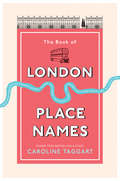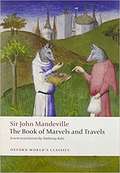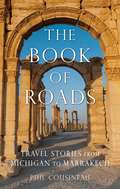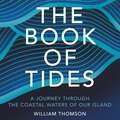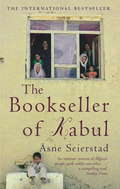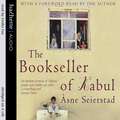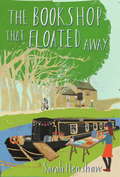- Table View
- List View
The Book of Ichigo Ichie: The Art of Making the Most of Every Moment, the Japanese Way
by Francesc Miralles Héctor GarcíaLearn to make every moment a once-in-a-lifetime experience with this definitive guide to the Japanese art of ichigo ichie, from the bestselling authors of Ikigai.Every moment in our life happens only once, and if we let it slip away, we lose it forever--an idea captured by the Japanese phrase ichigo ichie. Often spoken in Japan when greeting someone or saying goodbye, to convey that the encounter is unique and special, it is a tenet of Zen Buddhism and is attributed to a sixteenth-century master of the Japanese tea ceremony, or 'ceremony of attention', whose intricate rituals compel us to focus on the present moment.The Book of Ichigo-Ichie: The Art of Living of Making the Most of Every Moment, the Japanese Way is an inspirational work which shows us how to:* Free ourselves from the past and the future and to make each moment something unique.* Bring into our lives the Zen that Steve Jobs learned from a Japanese master, and which was key to his success.* Turn coincidences into a tool for conscious magic.* Create unforgettable moments in professional and personal circles.* Improve our relationships with a new type of mindfulness.* Open the floodgates to the flow of creativity whenever we need it.The Book of Ichigo Ichie will help you find your ikigai.(P) 2020 Quercus Editions Limited
The Book of London Place Names
by Caroline TaggartEver wondered if Cheapside really is cheap, what you do in Threadneedle Street, or who the knights of Knightsbridge were?Did you know that Piccadilly is actually an insult? And that Euston Road was built because there were too many cows on Oxford Street? Or that the River Fleet was covered over partly because of a drunken butcher? Take a trip down narrow lanes, through cobbled streets and crowded markets to discover the meanings behind the city’s place names. Meet forgotten residents whose names survive in the places where they lived, such as Sir George Downing of Downing Street, and uncover tales from London’s murky past that have shaped the modern city.From famous landmarks to forgotten rivers, grand thoroughfares to lost palaces, and ancient villages swallowed up as the city grew, Caroline Taggart explains the hidden meanings behind familiar places. If you have ever wanted to learn more about the history of London and discover the people, events and stories that shaped our capital city, then come on a journey that will show you London in a new light...
The Book of Marvels and Travels (Oxford World's Classics)
by John Mandeville Anthony BaleIn his Book of Marvels and Travels, Sir John Mandeville describes a journey from Europe to Jerusalem and on into Asia, and the many wonderful and monstrous peoples and practices in the East. Written in the fourteenth century, the Book is a captivating blend of fact and fantasy, an extraordinary travel narrative that offers some revealing and unexpected attitudes towards other races and religions. It was immensely popular, and numbered among its readers Chaucer, Columbus, and Thomas More. Here Mandeville tells us about the Sultan in Cairo, the Great Khan in China, and the mythical Christian prince Prester John. There are giants and pygmies, cannibals and Amazons, headless humans and people with a single foot so huge it can shield them from the sun. Forceful and opinionated, the narrator is by turns learned, playful, and moralizing, with an endless curiosity about different cultures. <P><P> Anthony Bale provides a lively new translation along with an introduction that considers questions of authorship and origins, the early travel narrative, Crusading and religious difference, fantasy and the European Age of Discovery, and Mandeville's pervasive popularity and influence. The book includes helpful notes on historical context that provide insights into medieval culture and attitudes. There are also three maps, an index of places and a general index, and a note on medieval measurements. <P><P> About the Series: For over 100 years Oxford World's Classics has made available the broadest spectrum of literature from around the globe. Each affordable volume reflects Oxford's commitment to scholarship, providing the most accurate text plus a wealth of other valuable features, including expert introductions by leading authorities, voluminous notes to clarify the text, up-to-date bibliographies for further study, and much more.
The Book of Roads
by Phil CousineauCousineau’s wanderlust has driven him to visit nearly 100 countries as a backpacker, documentary filmmaker, travel writer, photographer, and art and literary tour leader. For him, travel gives us what his mentor Joseph Campbell called "the key to the realm of the muses. ” As author of the best-selling travel book The Art of Pilgrimage, Cousineau continues to crisscross the world as a travel writer, filmmaker, and host of Global Spirit. The Book of Roads: Travel Stories from Michigan to Marrakech is the culmination of a lifetime of travel experiences, from the steel factories of Detroit to headhunting villages in the Philippines, the war-torn villages in the Balkans to the river roads of Canada once traversed by his voyageur ancestors. His rhapsodic travel stories place him in the league of fellow travelers who are also masterful writers, such as Pico Iyer, Jack Kerouac, Jan Morris, and Beryl Markham.
The Book of Roads: Travel Stories from Michigan to Marrakech
by Phil CousineauCousineau's wanderlust has driven him to visit nearly 100 countries as a backpacker, documentary filmmaker, travel writer, photographer, and art and literary tour leader. For him, travel gives us what his mentor Joseph Campbell called "the key to the realm of the muses." As author of the best-selling travel book The Art of Pilgrimage, Cousineau continues to crisscross the world as a travel writer, filmmaker, and host of Global Spirit. The Book of Roads: Travel Stories from Michigan to Marrakech is the culmination of a lifetime of travel experiences, from the steel factories of Detroit to headhunting villages in the Philippines, the war-torn villages in the Balkans to the river roads of Canada once traversed by his voyageur ancestors. His rhapsodic travel stories place him in the league of fellow travelers who are also masterful writers, such as Pico Iyer, Jack Kerouac, Jan Morris, and Beryl Markham.
The Book of Tides
by William ThomsonAn idiosyncratic, richly illustrated guide to Britain's rivers, seas and shores, for everyone who loves the water and the natural world - a Norwegian Wood for Britain's watersThis is a book for those who want to understand better how the waters surrounding us affect our daily lives, how it imperceptibly but crucially shapes our actions, and has shaped our landscape for millenia. It's for anyone who knows and loves our coast, and who wants to understand, discover, surf, or sail it better.Inspired by his own witnessing of the power of the sea through travelling around Britain's coastline in a panel van with his young family, William Thomson tells the story of the cycles of the sea. He combines a lyrical, passionate narrative with graphically beautiful renderings of the main forms of water which affect Britain: Rip, Rapids, Swell, Stream, Tide, Wave, Whirlpool, Tsunami.The Book of Tides is a book for all of us who feel the pull of the sea and the tug of the tide.
The Book of Tides
by William ThomsonAn idiosyncratic, richly illustrated guide to Britain's rivers, seas and shores, for everyone who loves the water and the natural world - a Norwegian Wood for Britain's watersThis is an audiobook for those who want to understand better how the waters surrounding us affect our daily lives, how it imperceptibly but crucially shapes our actions, and has shaped our landscape for millenia. It's for anyone who knows and loves our coast, and who wants to understand, discover, surf, or sail it better.Inspired by his own witnessing of the power of the sea through travelling around Britain's coastline in a panel van with his young family, William Thomson tells the story of the cycles of the sea. He combines a lyrical, passionate narrative with graphically beautiful renderings of the main forms of water which affect Britain: Rip, Rapids, Swell, Stream, Tide, Wave, Whirlpool, Tsunami.The Book of Tides is an audiobook for all of us who feel the pull of the sea and the tug of the tide.(P)2016 Quercus Publishing
The Book of Wonders: The perfect feel-good novel for 2021
by Julien SandrelOpen your heart to the most life-affirming and uplifting novel of the year...Thelma and Louis, it's always just been the two of them, Thelma and her beloved son, Louis.But when Louis is involved in an accident, their lives are turned upside down, as Louis falls into a coma. Feeling lost without him by her side, Thelma finds Louis' book of wonders - a bucket list of all the things he wants to accomplish in his life. She suddenly sees a way to feel close to him: she will fulfil Louis' dreams, living them out for him, in the hope that it will inspire him to survive.Thelma is about to set off on the adventure of a lifetime... and in a way, so is Louis...The Book of Wonders is a heart-warming and charming story about finding the joy in every moment of life and making each and every day count. Perfect for fans of The Keeper of Lost Things and A Man Called Ove.
The Book of Wonders: The perfect feel-good novel for 2021
by Julien SandrelOpen your heart to the most life-affirming and uplifting novel of the year...Thelma and Louis, it's always just been the two of them, Thelma and her beloved son, Louis.But when Louis is involved in an accident, their lives are turned upside down, as Louis falls into a coma. Feeling lost without him by her side, Thelma finds Louis' book of wonders - a bucket list of all the things he wants to accomplish in his life. She suddenly sees a way to feel close to him: she will fulfil Louis' dreams, living them out for him, in the hope that it will inspire him to survive.Thelma is about to set off on the adventure of a lifetime... and in a way, so is Louis...The Book of Wonders is a heart-warming and charming story about finding the joy in every moment of life and making each and every day count. Perfect for fans of The Keeper of Lost Things and A Man Called Ove.
The Book of Wonders: The perfect feel-good novel for summer 2020!
by Julien SandrelOpen your heart to the most life-affirming and uplifting novel of the year...Thelma and Louis, it's always just been the two of them, Thelma and her beloved son, Louis.But when Louis is involved in an accident, their lives are turned upside down, as Louis falls into a coma. Feeling lost without him by her side, Thelma finds Louis' book of wonders - a bucket list of all the things he wants to accomplish in his life. She suddenly sees a way to feel close to him: she will fulfil Louis' dreams, living them out for him, in the hope that it will inspire him to survive.Thelma is about to set off on the adventure of a lifetime... and in a way, so is Louis...The Book of Wonders is a heart-warming and charming story about finding the joy in every moment of life and making each and every day count. Perfect for fans of The Keeper of Lost Things and A Man Called Ove.
The Book of Yaak
by Rick BassThe Yaak Valley of northwestern Montana is one of the last great wild places in the United States, a land of black bears and grizzlies, wolves and coyotes, bald and golden eagles, wolverine, lynx, marten, fisher, elk, and even a handful of humans. It is a land of magic, but its magic may not be enough to save it from the forces threatening it now. The Yaak does have one trick up its sleeve, though: a writer to give it voice. In Winter Rick Bass portrayed the wonder of living in the valley. In The Book of Yaak he captures the soul of the valley itself, and he shows how, if places like the Yaak are lost, we too are lost. Rick Bass has never been a writer to hold back, but The Book of Yaak is his most passionate book yet, a dramatic narrative of a man fighting to defend the place he loves.
The Book of the Thousand Nights and a
by AnonymousThis first of nine volumes accurately translating the wonderful tales of the Arabian nights.
The Book of the Thousand Nights and a
by AnonymousThis second of nine volumes accurately translating the wonderful tales of the Arabian nights.
The Book of the Thousand Nights and a
by AnonymousThis third of nine volumes accurately translating the wonderful tales of the Arabian nights.
The Book of the Thousand Nights and a
by AnonymousThis fourth of nine volumes accurately translating the wonderful tales of the Arabian nights.
The Book of the Thousand Nights and a
by AnonymousThis fifth of nine volumes accurately translating the wonderful tales of the Arabian nights.
The Book of the Thousand Nights and a
by AnonymousThis sixth of nine volumes accurately translating the wonderful tales of the Arabian nights.
The Book of the Thousand Nights and a
by AnonymousThis seventh of nine volumes accurately translating the wonderful tales of the Arabian nights.
The Book of the Thousand Nights and a
by AnonymousThis eighth of nine volumes accurately translating the wonderful tales of the Arabian nights.
The Book of the Thousand Nights and a
by AnonymousThis last of nine volumes accurately translating the wonderful tales of the Arabian nights.
The Bookseller Of Kabul: The International Bestseller
by Asne SeierstadTHE INTERNATIONAL BESTSELLER <P><P>For more than twenty years Sultan Khan, a bookseller in Kabul, defied the authorities - be they communist or Taliban - to supply books to the people of Kabul. He was arrested, interrogated and imprisoned by the communists and watched illiterate Taliban soldiers burn piles of his books in the street. He even resorted to hiding most of his stock in attics all over Kabul. But while Khan is passionate in his love of books and hatred of censorship, he is also a committed Muslim with strict views on family life. Two weeks after September 11th, award-winning journalist Åsne Seierstad went to Afghanistan to report on the conflict there and the year after she lived with an Afghan family for several months. As an outsider, Asne Seierstad is able to move between the private world of the women - including Khan's two wives - and the more public lives of the men. And so we learn of proposals and marriages, suppression and abuse of power, crime and punishment. The result is a gripping and moving portrait of a family, and a clear-eyed assessment of a country struggling to free itself from history. <P><P>'An intimate portrait of Afghani people quite unlike any other ... a compelling read' CHRISTINA LAMB, SUNDAY TIMES
The Bookseller Of Kabul: The International Bestseller
by x Asne SeierstadTHE INTERNATIONAL BESTSELLERFor more than twenty years Sultan Khan, a bookseller in Kabul, defied the authorities - be they communist or Taliban - to supply books to the people of Kabul. He was arrested, interrogated and imprisoned by the communists and watched illiterate Taliban soldiers burn piles of his books in the street. He even resorted to hiding most of his stock in attics all over Kabul. But while Khan is passionate in his love of books and hatred of censorship, he is also a committed Muslim with strict views on family life. Two weeks after September 11th, award-winning journalist Åsne Seierstad went to Afghanistan to report on the conflict there and the year after she lived with an Afghan family for several months. As an outsider, Asne Seierstad is able to move between the private world of the women - including Khan's two wives - and the more public lives of the men. And so we learn of proposals and marriages, suppression and abuse of power, crime and punishment. The result is a gripping and moving portrait of a family, and a clear-eyed assessment of a country struggling to free itself from history.'An intimate portrait of Afghani people quite unlike any other ... a compelling read' CHRISTINA LAMB, SUNDAY TIMES
The Bookseller Of Kabul: The International Bestseller - 'An intimate portrait of Afghani people quite unlike any other' SUNDAY TIMES
by Åsne SeierstadFor more than twenty years Sultan Khan defied the authorities to supply books to the people of Kabul. He was arrested, interrogated and imprisoned, and watched illiterate soldiers burn piles of his books in the street.In spring 2002 award-winning journalist Åsne Seierstad spent four months living with the bookseller and his family. As she steps back from the page and lets the Khans tell their stories, we learn of proposals and marriages, hope and fear, crime and punishment. The result is a unique portrait of a family and a country.'A remarkable portrait, with deftly woven accounts of weddings and journeys, books and bookselling, relations and squabbles, firmly anchored by pleasing details about food and customs, all set against the backdrop of a derelict city, filthy and crammed but not defeated ... [Seierstad] was fascinated by everything she witnessed, and her curiosity and perceptive eye colours every page' INDEPENDENT
The Bookshop That Floated Away
by Sarah HenshawIn early 2009 a strange sort of business plan landed on the desk of a pinstriped bank manager. It had pictures of rats and moles in rowing boats and archaic quotes about Cleopatra's barge. It asked for a £30,000 loan to buy a black-and-cream narrowboat and a small hoard of books. The manager said no. Nevertheless The Book Barge opened six months later and enjoyed the happy patronage of local readers, a growing number of eccentrics and the odd moorhen.Business wasn't always easy, so one May morning owner Sarah Henshaw set off for six months chugging the length and breadth of the country. Books were bartered for food, accommodation, bathroom facilities and cake. During the journey, the barge suffered a flooded engine, went out to sea, got banned from Bristol and, on several occasions, floated away altogether. This account follows the ebbs and flows of Sarah's journey as she sought to make her vision of a floating bookshop a reality.
The Bookshop on Primrose Hill: The new cosy and uplifting read set in a gorgeous London bookshop from New York Times bestselling author Sarah Jio
by Sarah Jio'If you are a lover of books, handwritten letters, literature, quaint bookshops, vintage, and the charm of London, this magical treasure is a must-read' Judy, Goodreads reviewer'An emotional, vibrant love letter to bookstores, moms/daughters and second acts' Kari-Ann, Goodreads reviewer***Valentina Baker was only eleven years old when her mother, Eloise, suddenly fled to London, leaving Val and her father on their own in California. Now a librarian in her thirties, Val is fresh out of a failed marriage and utterly disenchanted with life.One day, Val receives word that Eloise has died, leaving Val the deed to both her mother's Primrose Hill apartment and the bookshop she opened twenty years ago. As Val jets across the Atlantic, she wonders - could this be her chance at a new beginning?In London, Val finds herself falling in love with the pastel-coloured flat and the cosy, treasure-filled bookshop. When she stumbles across a series of intriguing notes left in a beloved old novel, it's the start of a scavenger hunt that will take her all over London and back in time... but most of all, bring her closer to the mother she lost twice.Bittersweet and uplifting, The Bookshop on Primrose Hill will steal your heart. Perfect for fans of The Bookish Life of Nina Hill and How to Find Love in a Bookshop. Published in the US as With Love from London.

